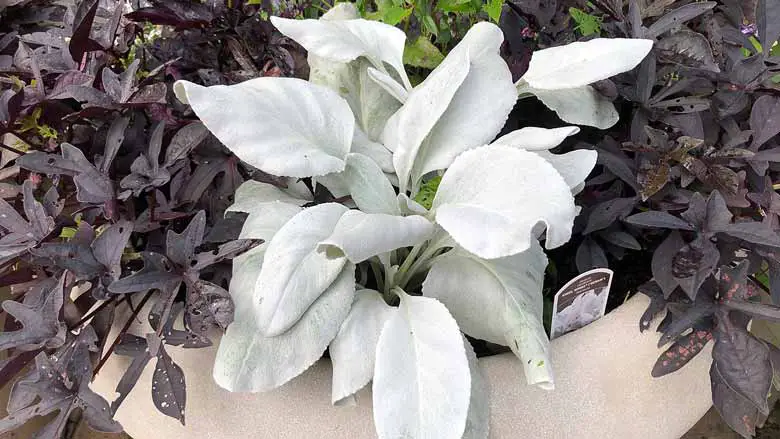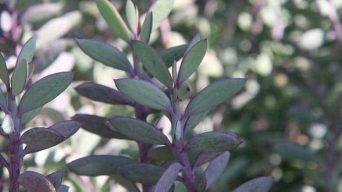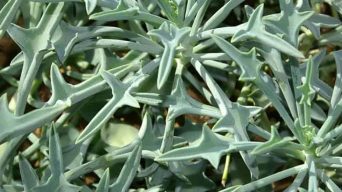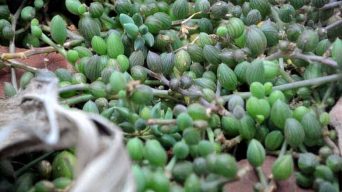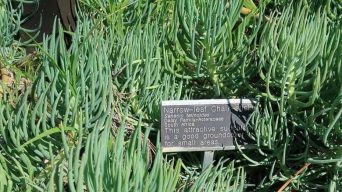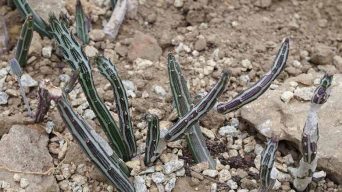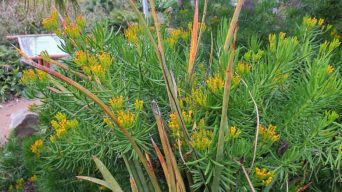The Senecio candicans ‘Angel Wings’ succulent plant is a beautiful and unique addition to any garden.
It’s easy to propagate, care for, and enjoy, making it the perfect choice for novice growers!
This complete guide will teach you how to take care of and propagate your Senecio Angel Wings so that they can thrive in your yard.
Overview
Senecio candicans, commonly known as Angel Wings, is a fast-growing succulent flowering plant of the Asteraceae family that is native to South America.
The Senecio Angel Wings is a stunning perennial succulent plant with silvery, large, soft to the touch leaves that grows up to 16 inches (40 cm) tall.
The leaves of this plant can grow up to 7 inches (18 cm) tall and 5 inches (12 cm) wide.
The Angel Wings plant blooms in the summertime and produces an inflorescence of small yellow flowers.
This plant is commonly known as:
- Senecio Angel Wing
- Senaw
- Marine cineraria ‘Angel Wings’
- Sea Cabbage ‘Angel Wings’
- Senecio Candicans ‘Senaw’
How To Care for Senecio Candicans ‘Angel Wings’
Senecio Angel Wings care is actually relatively simple and easy to do once you know what to do.
There are a few essential things that Senecio candicans care includes.
The following are the main points to provide proper care for Senecio candicans ‘Angel Wings’ succulent plants.
Sun Exposure & Light Requirements
Senecio candicans ‘Angel Wings’ can be grown in either full sun or partial shade. It may also be able to tolerate some full shade.
It needs six hours of sunlight per day to thrive, so place it in a location that receives a lot of natural light.
The plant can take full sun but will do better with at least a little shade during the hottest parts of summer. Provide it with some morning or afternoon shade in hot locations to avoid scorching its leaves.
This Senecio is not very demanding when it comes to light levels and should grow indoors as long as there are windows that get plenty of natural sunlight.
It also does well outdoors, where it is exposed to direct sun for part of the day.
The Senecio candicans ‘Angel Wings’ succulent prefers partial shade rather than no shading, so make sure you provide this before transplanting outside permanently.
A few hours of exposure per day to bright indirect light (such as from a window) would suffice for indoor Senecios.
Watering Requirements
Angel Wings Senecio requires only occasional watering.
In general, senecios are pretty easy to grow, and they will survive prolonged periods of drought with no ill effects.
The soil should dry out between waterings so that the plant can get a chance to use up its stored moisture before you give it more water again.
If Senecio succulent plants are overwatered, they will rot.
The soil should be moist but not soggy for the best results and growth of your Senecios.
It is okay if water runs off because it means that you have planted them in a sandy or porous potting mix with good drainage holes, and there is no standing water in the container to cause problems when watering.
Soil Requirements
Senecio Angel Wings are very tolerant of soil and water conditions but will benefit from a sandy soil mix that provides good drainage for their roots.
A succulent-friendly planting medium like cacti/succulent potting mix should work well (it has more aggregate than regular potting soils) and enable better aeration around the plant’s roots when appropriately watered.
It doesn’t have to be sterile, but if you grow in regular potting soil, add some perlite or coarse sand to the mix.
This will help with drainage and aeration of the roots.
A 50% – 75% mixture of succulent planting mediums such as cacti/succulent potting substrate is recommended for these plants because they do not have root systems that grow deep into the ground like desert cacti varieties typically found in xeriscape gardens.
Temperature and Humidity
Temperature and humidity are the two significant factors affecting Senecio candicans ‘Angel Wings’ growth.
They can be controlled with a combination of natural sunlight, shade cloths or trees, and open windows in the evening for coolness.
The ideal temperature range is from 65-85 degrees Fahrenheit (18-30 Celsius).
The optimum relative humidity should be between 60% – 80%.
One way to achieve this is by using large clay pots, which hold water better than plastic ones because they dry more slowly.
It’s also important to use soil that holds moisture well, like cacti mix or compost soil blend.
Fertilizing
Fertilizing Senecio candicans plants is important for good growth and production of flowers.
The more nutrients available, the faster it will grow.
Fertilize Senecio Angel Wings every few months if you see signs of yellowing or weakening leaves (decreasing leaf size).
Fertilization helps to promote new plant growth, flowering, and heavy senescing in most Senecio species.
You can use a water-soluble fertilizer mixed at half strength.
A balanced formula that contains nitrogen, phosphorus, and potassium is recommended for Senecio plants in the garden or landscape.
Potting and Repotting
Once your plant has grown too big for its pot, you will need to repot it.
There are many ways to do this, and the perfect method depends on your soil mix.
If you are going to plant a cactus or succulent, you need to remove the old soil. Cut off any dead roots with sharp scissors. Take care of any pests that might be hiding in the crevices during transport.
Then put it into a new pot with fresh soil.
It’s important to use a pot with drainage holes. This will allow the soil to stay light and not compact as much, which helps ensure proper airflow around the root system.
The hole size should be less than an inch wide but more than just a pinhole so water can drain away quickly without causing too much sogginess or slope for your plant’s roots.
If you are going to plant in the ground, then be sure that there is plenty of room for roots and stem tissue.
Gently loosen up and break any clumps before planting so they can breathe freely without being compacted together or smothered by too much soil.
Water thoroughly after repotting your plants, but don’t overwater them, as this may cause root rot!
Pruning
Pruning Senecio candicans ‘Angel Wings’ is a great way to keep it compact and healthy.
After it has flowered and senesced (no new leaves will grow), cut off any dead or dying branches in the early spring.
Prune back to a healthy stem, ensuring that you always cut above a leaf node on an upright stem.
Pests and Diseases
Diseases and pests can be a concern with Senecio plants like the Angel Wings.
Pests
These pests may come in contact with your plant by feeding on its leaves, sucking sap from it, or even laying eggs near it. They can also spread disease as they walk around the potting soil looking for food.
For example, mealybugs are common garden potted Senecios pests that feed on Senecio candicans succulent foliage and lay their white flaky egg sacs along leaf edges when there is too much moisture.
Over time, these insects will form colonies, leading to Senecio plants losing vigor because of reduced photosynthesis rates due to less sunlight reaching them through infested leaves covered in waxy honeydew.
Some potential solutions for this are:
- Removing Senecios infested leaves
- Using an insecticidal soap spray or neem oil in the soil mix
- Wiping down any honeydew with a cloth dampened with water early on before it becomes too thick/sticky
- Keeping Senecio plants out of direct sunlight so that they do not stress themselves (which can cause sap production)
These things should help if you notice your Senecio becoming unhealthy because of a pest problem.
Diseases
Likewise, some common Senecio diseases include damping-off, powdery mildew, and rust.
Damping Off
Damping-off is a fungal disease that causes the death of plant seedlings due to rotting roots or stems from too much moisture in potting soil.
This can be prevented by keeping potting soils on the dry side but not so dry they suppress root growth.
Powdery Mildew
Powdery mildew will affect Senecios plants with high humidity levels for extended periods.
This disease covers Senecio plants with a white powder and can be spread by the movement of spores on clothing or shoes.
Powdery mildew can be prevented by reducing humidity levels in the garden or potting.
Rust
Rust is also common for Senecios in humid climates because it thrives off moisture. It includes yellow-brown spots on Senecio plant leaves that may grow more significant as time goes on if left untreated.
If you notice any reddish-brown patches on Senecio Angel Wings succulent foliage, then this could indicate rust infection at its early stages from too much humidity/watering, so act fast to prevent more damage!
One way to treat Senecio rust would be wiping down infected areas with rubbing alcohol which will kill the fungus without harming your plant’s health.
How to Care for Senecio Angel Wings in Winter
As Senecio Angel Wings succulent plants are from the desert region, they need a dry winter.
This plant is not frost tolerant, so it should be brought back into the house before temperatures drop below 32°F (0°C).
It’s better to keep them inside and place them near a window or under grow lights if you plan on keeping these plants alive through the winter months.
If you cannot keep the Angel Wings Senecio inside, they should be brought into an unheated garage or greenhouse.
It’s essential that it is dry and has excellent air circulation so that Senecio candicans ‘Angel Wings’ doesn’t rot from dampness.
In this case, cut back on watering until conditions improve in springtime.
How To Propagate Senecio Candicans ‘Angel Wings’
Senecio candicans ‘Angel Wings’ can be propagated by cuttings and seeds.
Cuttings
One way to propagate Senecio Angel Wings is by taking cuttings.
- First, be sure to trim a healthy Senecio plant.
- Cut off a piece of the stem that has at least three or four nodes on it and is about eight inches long.
- Allow the cutting to callus over for a few days before planting.
- Keep it well-drained, providing ample water and bright light.
- Keep the soil moist for at least two weeks to encourage rooting.
After a few months, Senecio cuttings can be removed from their pots and planted in larger containers or outdoors once they have rooted.
Seeds
Another way of propagating Senecio candicans ‘Angel Wings’ is through seeds.
Take some seed pods and plant these into sterile soil for growing succulents – you can also dry out the pods before planting them, if they are fresh enough!
Keep an eye on watering, sunlight exposure (give plenty), temperature, etc.; otherwise, wait patiently for growth to begin!
Make sure that once planted into containers, each one has individual space around its base so they grow happily and healthy, sprawling outwards.
You can also try planting Senecio seeds in the ground! This is a little more difficult to do as they need light to germinate – but it’s worth trying if you have space available outside your home where Senecios could grow.
Is the Senecio Angel Wings Toxic?
The Senecio Angel Wings is not toxic, but you should avoid handling it if you have sensitive skin.
If your Senecio ‘Angel Wings’ succulent plant has been damaged or broken in any way (e.g., from transplantation), then handle it with care because of the sap that can be released and irritate your skin.
Final Thoughts
The Senecio candicans ‘Angel Wings’ is a beautiful houseplant with an easy-care level and propagation.
It is best to keep the Senecio Angel Wings in a pot where it can be watered and taken care of.
These plants are perfect for beginners but also bring along their charm for more advanced growers.
Since Senecio Angel Wings are easy to grow and with good care, these plants will be a great addition to any garden or home and brighten up the day for anyone who sees them!

